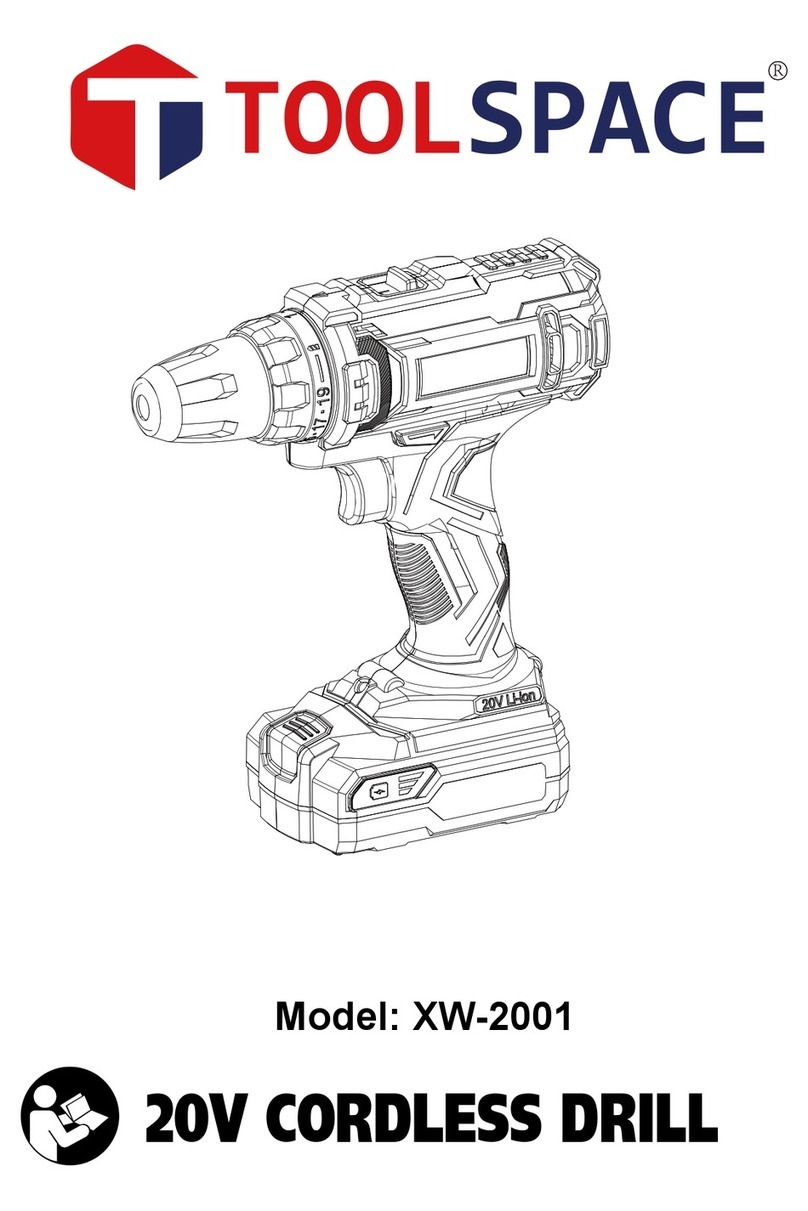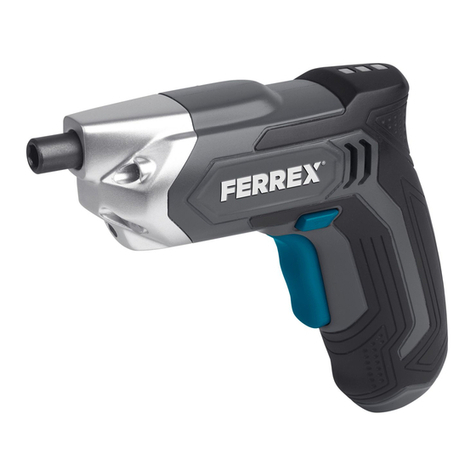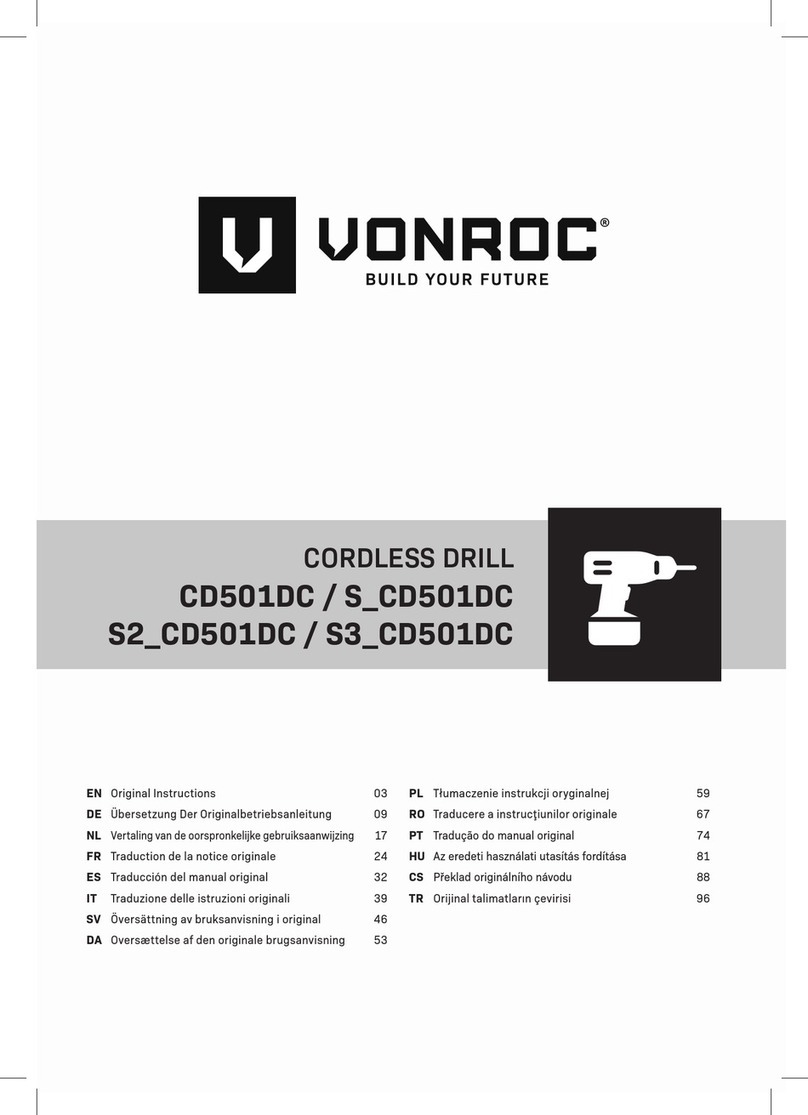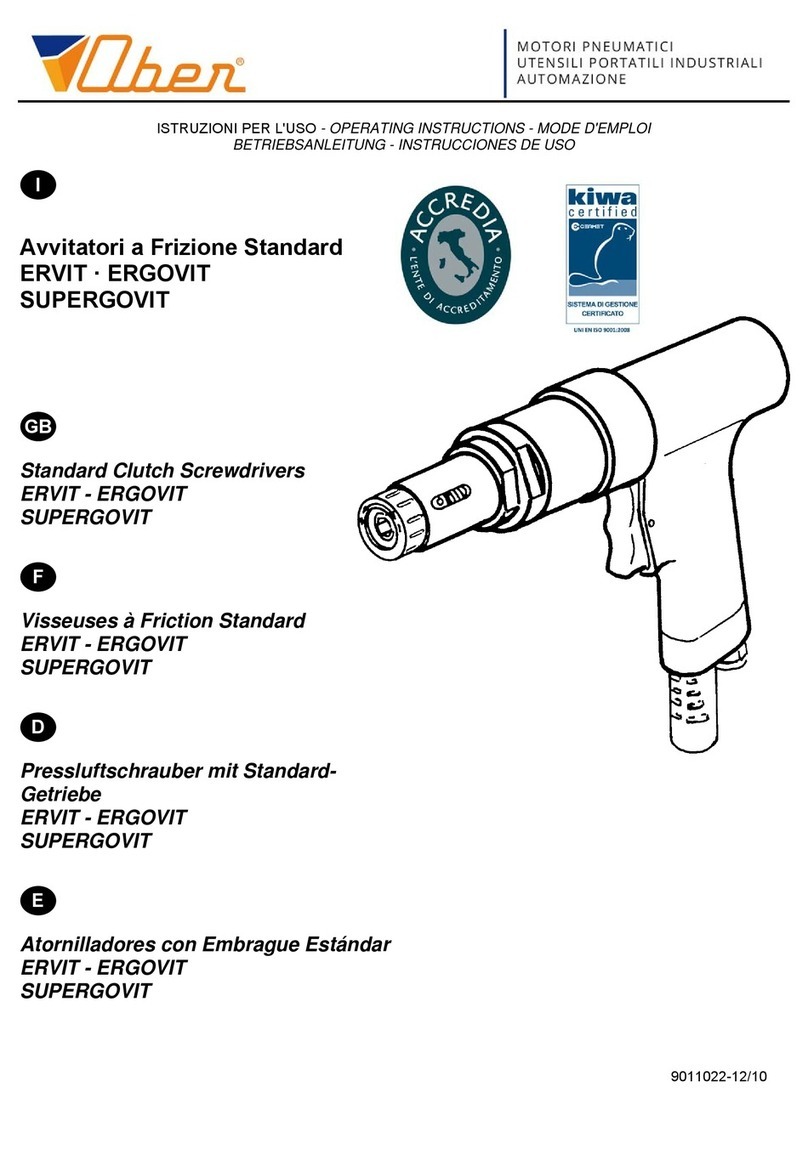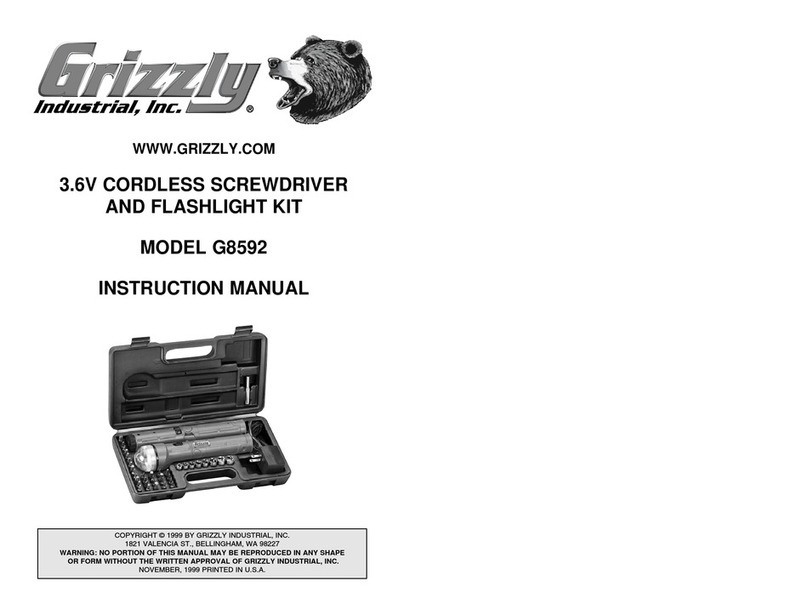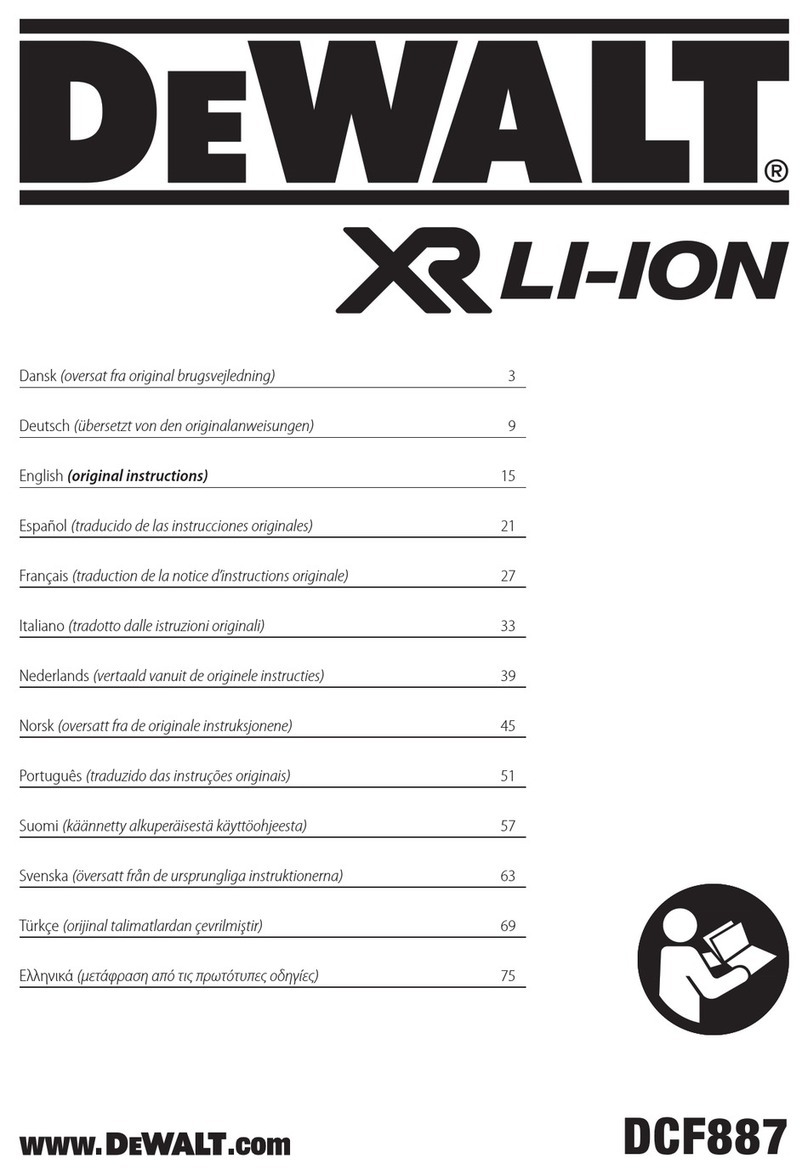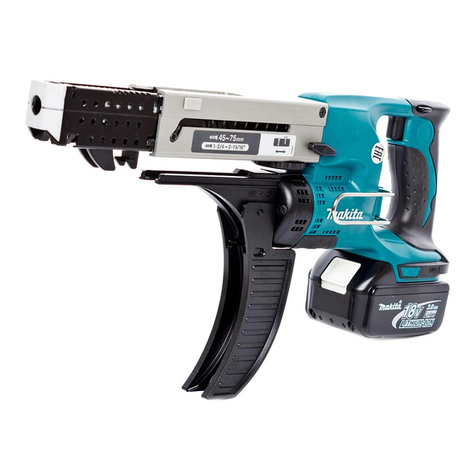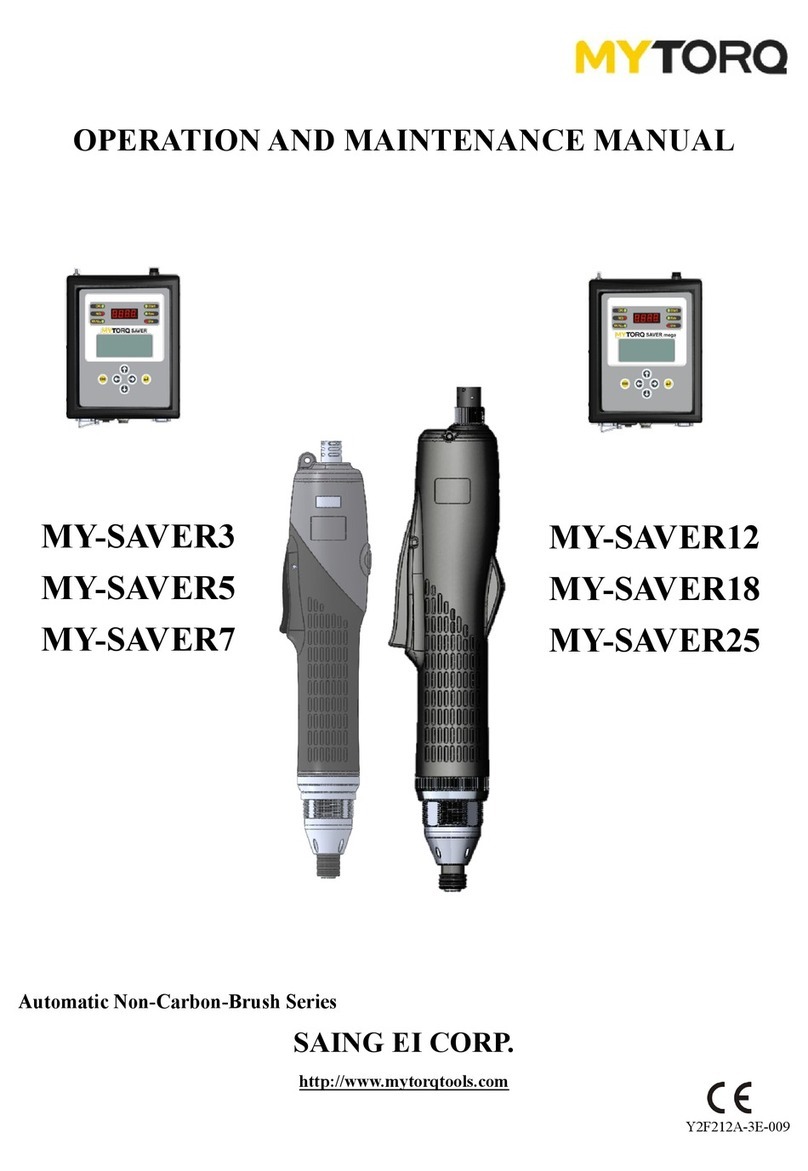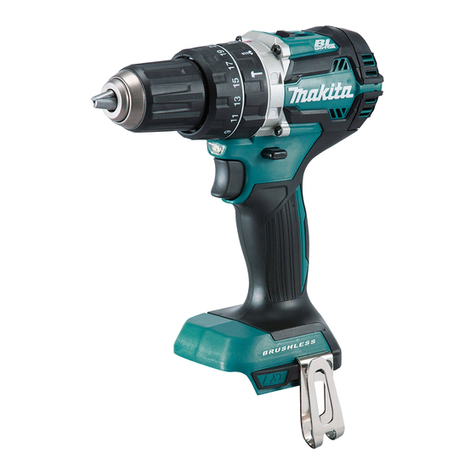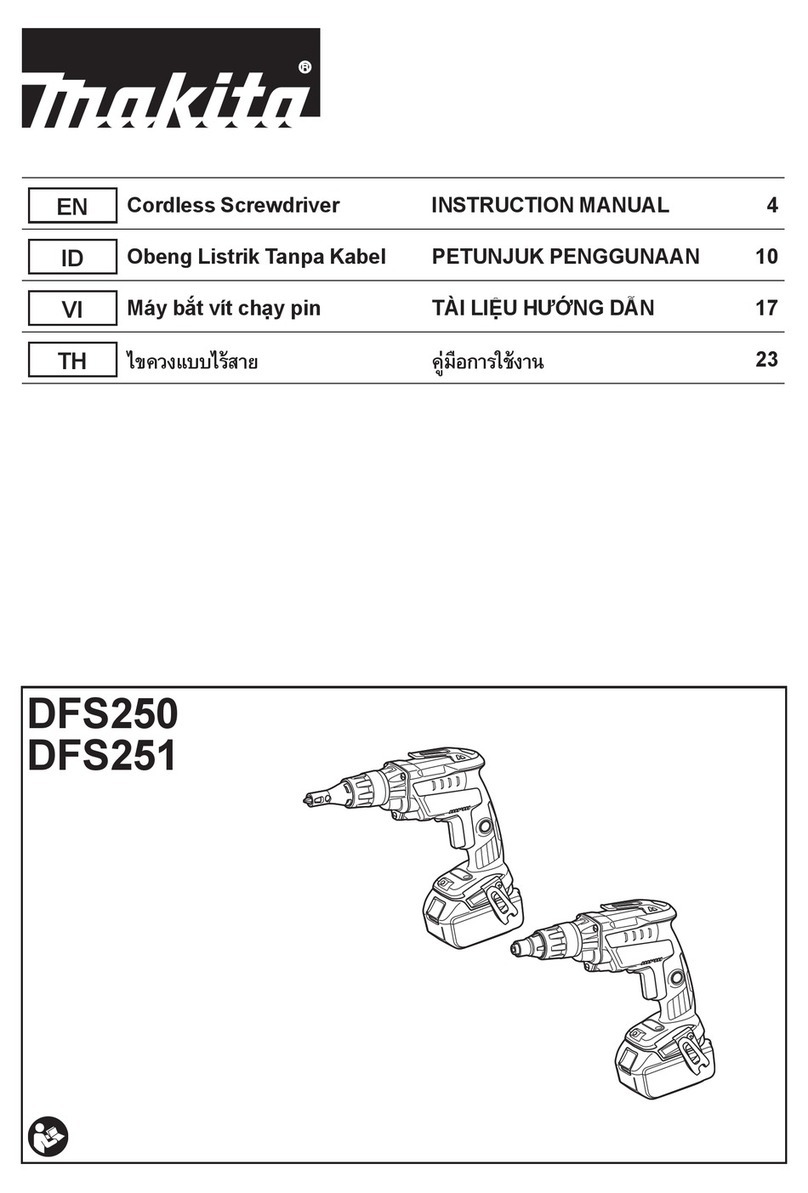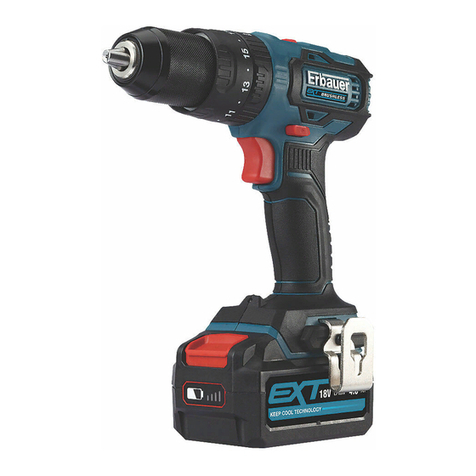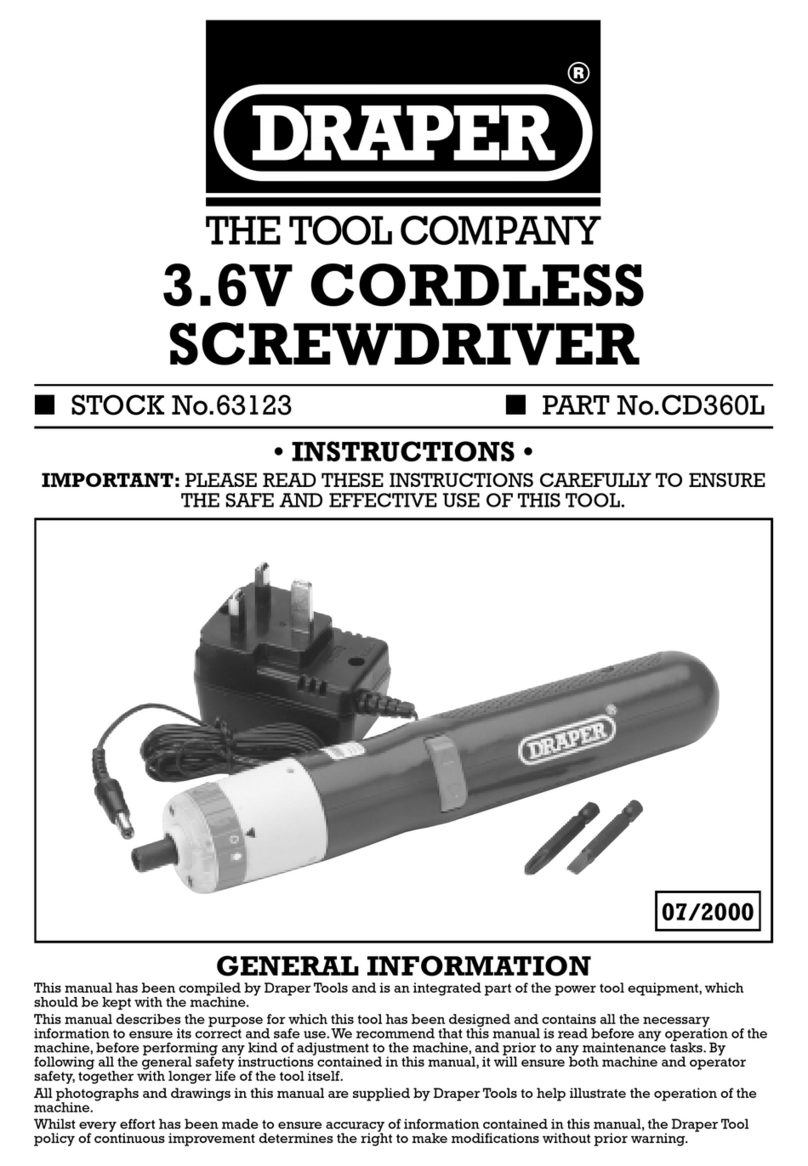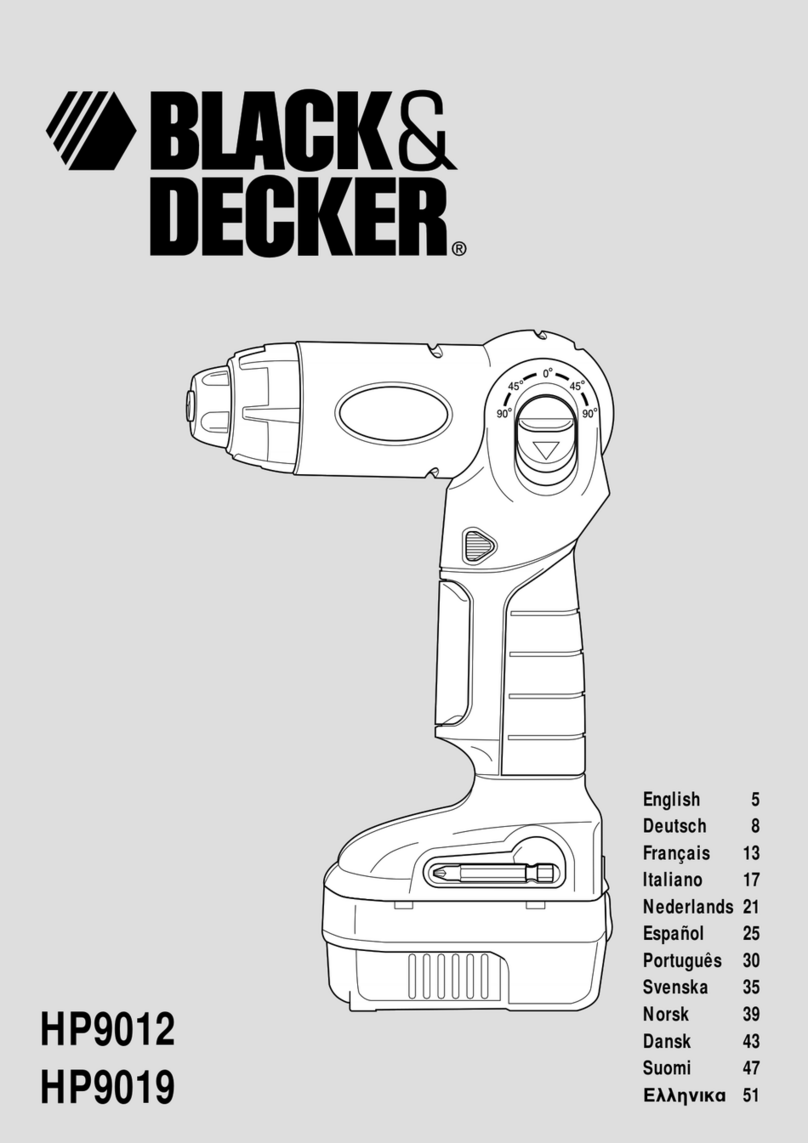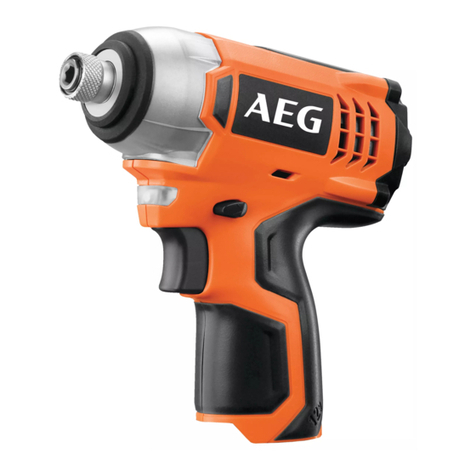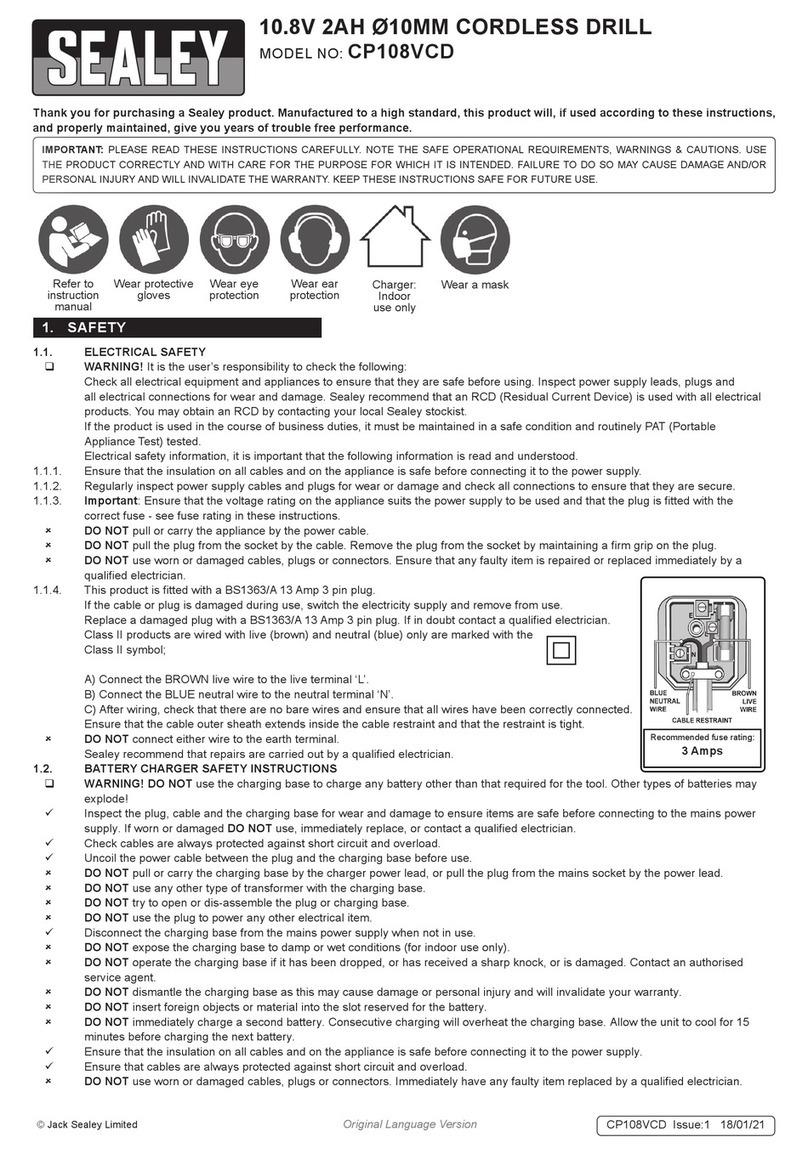TOOLSPACE XW-1201 User manual

12V CORDLESS DRILL
Model: XW-1201

Dear Customer,
Thank you for your purchase.
Your purchase means the world to us.
If you have any questions, we are here to service you.
lf the product you received is damaged or has quality
problems, please contact us through Email below and
attach product pictures of related problems,we will
reply to you as soon as possible,and provide you with
the best solution.
Email: TOOLSPACE01@outlook.com
Best regards,
Toolspace Customer Service Team

Polarity
Do not discard electrical appliances with household waste.
CONGRATULATIONS ON YOUR PURCHASE OF OUR PRODUCT. This instruction manual is intended
primarily to familiarise the operator with safety, installation, operation, maintenance, product storage and
troubleshooting and it provides important information. So keep it well so that other users can information in the future
too. Due to the constant development and adaptation to the latest demanding EU standards, technical and optical changes
can be made to the products without prior notice. Photos and drawings in this instruction manual may only be illustrative.
Therefore, no legal claims related to this instruction manual, in particular any slight minor deviations from the information
contained therein, can be applied if the product continues to meet all of the above mentioned standards and
declarations, and works as described. In case of confusion, contact the importer or retailer.
Before the first operation, please read the owner’s manual carefully!
The battery contains toxic substances.
Please dispose of batteries at your local battery disposal depot.
IPX1
T3,15A
Do not store or use the battery in
locations where the temperature may reach or exceed 50°C!
Do not throw the battery into fire.
Do not throw the battery into water.
Do not throw the battery into household waste.
Use ear protection.

MACHINE DESCRIPTION
1
1

SPECIFICATIONS
A. Jaws
B. Front sleeve of drill chuck
C. Rear sleeve of drill chuck
D. Torque selector ring
E. Speed function switch
F. Led light
G. On / Off switch
H. Battery compartment release button
I. Battery
J. Vent holes
K. Battery capacity indicator
L. Rotational direction switch
M. Handle
N. Battery charger
Rated voltage 12 V DC
Battery type Li-Ion
Capacity 1500 mAh
Charge time ca.
(hours) 3 - 5 h
Input voltage 100 - 240 V ~
Frequency 50/60 Hz
Input current 0,4 A
Output voltage 13,5 V DC
Output current 0,5 A
Protection class II
Battery charger
Battery

The declared total vibration value(s) and noise emission value(s) were determined
using the standard test method and may be used to compare one tool with another.
The declared total vibration value(s) and noise emission value(s) may be used to pre-
determine exposure.
WARNING
- vibration and noise emissions during actual use of the tool may differ from the
declared values depending on the way the tool is used, particularly on the type of
workpiece being machined.
- safety measurements must be specified to protect the operator based on exposure
assessment under actual conditions of use (taking into account all parts of the duty
cycle, such as the time the tool is off and idle except for the start time).
Maximum torque 22 Nm
Torque setting 19 + 1
Drill chuck capacity 10 mm
No load speed
speed 1
speed 2
0-350 / min.
0-1300 / min.
Right-left turning
LED light
Weight with battery 1050 g
Weight without battery 850 g
Operating conditions 0°C - +35°C
Sound power level A,
L
WA
m / Uncertainty of
K
WA
L
WA
= 90 dB (A) / K = 3 dB (A)
Emission sound pressure
level A, L
pA
m at the
operator's station /
Uncertainty of K
pA
L
pA
= 79 dB (A); K = 3 dB (A)
Vibrations on the handle
< 2,5 m/s
2
K = 1,5 m/s
2
Tool

2 3
4
5
8
7
6

CONDITIONS OF USE
WARNING!
PLEASE READ THE OPERATING INSTRUCTIONS! Read all instructions before operation.
Pay special attention to safety instructions.
FAILURE TO FOLLOW THE INSTRUCTIONS AND FAILURE TO RESPECT SECURITY
MEASURES MAY RESULT IN DAMAGE OF THE PRODUCT OR SERIOUS INJURIES OR
EVEN FATAL INJURY.
If you notice any damage during transport or unpacking, notify your supplier immediately. DO
NOT PUT INTO OPERATION.
SPECIFIC TERMS AND CONDITIONS OF USE
This product is exclusively intended for the use:
- for tightening and loosening screws
- according to the corresponding descriptions and safety instructions in these operating
instructions.
Any other use is not as intended.
The tool is not designed for use with attachments
If the product is used for any purpose other than the intended purpose or if unauthorized
is made, the statutory warranty and statutory responsibility for defects as
well as any liability on the part of the manufacturer will be void.
Do not overload! Use the product only for the powers it was designed for. The product
designed for a given purpose performs it better and safer than one that has a similar function.
Therefore, always use the correct one for a given purpose.
Please keep in mind that our products are not designed for commercial, trade or industrial use
according to their intended purpose. We accept no liability if the product is used in these or
comparable conditions.
Where it is required, follow the legal guidelines and regulations to prevent possible
accidents during operation.
CAUTION!
Never use the product if it is close to people, especially children or pets.
The user is liable for all damages caused to third parties or their property.

Keep these instruction manual and use them whenever you need more information.
If you don´t understand some of these instructions, contact your dealer. If
the product is lent to another person, it is necessary to lent this instruction manual
with it.
TRAINING
All operating personnel must be adequately trained in the use, operation and
setting and especially familiar with prohibited activities.
• Never allow use by children or people unfamiliar with these instructions. Local regulations
may specify an age limit of the operator.
• This product is not intended for use by persons with reduced sensory or mental capacity
or lack of experience and knowledge - unless they are under the supervision of the person
responsible for their safety or if this person has instructed how use this product. The product
is not intended for use by children and persons with reduced mobility or poor physical
disposition. We strongly recommend to pregnant women to contact her doctor before use
of this product.
• Respect national/local regulations regarding working time (please, contact your local
authority).
SAFETY INSTRUCTIONS
• Know your tool. Read owner’s manual carefully. Learn its applications and
limitations as well as the potential hazards related to this tool. Familiarise
yourself with the controls on the machine and how to use them.
• Be careful at work, be concentrated on actual work, and use the common sense.
• An inattention during work may result in loss of control over the machine.
WARNING!
Failure to follow the warnings and instructions may result in electric shock, re and/
or serious injury.
The term “power tool” in the warnings refers to your mains-operated (corded) power tool or
battery-operated (cordless) power tool.
WORK AREA SAFETY
a. Keep work area clean and well lit.
Cluttered or dark areas invite accidents.
b. Do not operate power tools in explosive atmospheres, such as in the presence of
liquids, gases or dust.
Power tools create sparks which may ignite the dust
or fumes.
c. Keep children and bystanders away while operating a power tool.
Distractions can
cause you to lose control.

ELECTRICAL SAFETY
a. Power tool plugs must match the outlet. Never modify the plug in any way. Do not
use any adapter plugs with earthed (grounded) power tools.
plugs and
matching outlets will reduce risk of electric shock.
b. Avoid body contact with earthed or grounded surfaces, such as pipes, radiators,
ranges and refrigerators.
There is an increased risk of electric shock if your body is earthed
or grounded.
c. Do not expose power tools to rain or wet conditions.
Water entering a power tool will
increase the risk of electric shock.
d. Do not abuse the cord. Never use the cord for carrying, pulling or unplugging
the power tool. Keep cord away from heat, oil, sharp edges or moving parts.
Damaged or entangled cords increase the risk of electric shock.
e. When operating a power tool outdoors, use an extension cord suitable for outdoor
use.
Use of a cord suitable for outdoor use reduces the risk of electric shock.
f. If operating a power tool in a damp location is unavoidable, use a residual current
device (RCD) protected supply.
Use of an RCD reduces the risk of electric shock.
PERSONAL SAFETY
a. Stay alert, watch what you are doing and use common sense when operating
a power tool. Do not use a power tool while you are tired or under the of
drugs, alcohol or medication.
A moment of inattention while operating power tools may
result in serious personal injury.
b. Use personal protective equipment. Always wear eye protection.
Protective
equipment such as a dust mask, non-skid safety shoes, hard hat or hearing protection used
for appropriate conditions will reduce personal injuries.
c. Prevent unintentional starting. Ensure the switch is in the off-position before
connecting to power source and/or battery pack, picking up or carrying the tool.
Carrying power tools with your on the switch or energising power tools that have
the switch on invites accidents.
d. Remove any adjusting key or wrench before turning the power tool on.
A wrench or
a key left attached to a rotating part of the power tool may result in personal injury.
e. Do not overreach. Keep proper footing and balance at all times.
This enables better
control of the power tool in unexpected situations.
f. Dress properly. Do not wear loose clothing or jewellery. Keep your hair and clothing
away from moving parts.
Loose clothes, jewellery or long hair can be caught in moving
parts.
g. If devices are provided for the connection of dust extraction and collection facilities,
ensure these are connected and properly used.
Use of dust collection can reduce dust-
related hazards.
h. Do not let familiarity gained from frequent use of tools allow you to become
complacent and ignore tool safety principles.
A careless action can cause severe injury
within a fraction of a second.
POWER TOOL USE AND CARE
a. Do not force the power tool. Use the correct power tool for your application.
The correct power tool will do the job better and safer at the rate for which it was designed.

b. Do not use the power tool if the switch does not turn it on and off.
Any power tool
that cannot be controlled with the switch is dangerous and must be repaired.
c. Disconnect the plug from the power source and/or remove the battery pack, if
detachable, from the power tool before making any adjustments, changing
accessories, or storing power tools.
Such preventive safety measures reduce the risk of
starting the power tool accidentally.
d. Store idle power tools out of the reach of children and do not allow persons
unfamiliar with the power tool or these instructions to operate the power tool.
Power tools are dangerous in the hands of untrained users.
e. Maintain power tools and accessories. Check for misalignment or binding of
moving parts, breakage of parts and any other condition that may affect the power
tool’s operation. If damaged, have the power tool repaired before use.
Many
accidents are caused by poorly maintained power tools.
f. Keep cutting tools sharp and clean.
Properly maintained cutting tools with sharp cutting
edges are less likely to bind and are easier to control.
g. Use the power tool, accessories and tool bits etc. in accordance with these
instructions, taking into account the working conditions and the work to be
performed.
Use of the power tool for operations different from those intended could result
in a hazardous situation.
h. Keep handles and grasping surfaces dry, clean and free from oil and grease.
Slippery
handles and grasping surfaces do not allow for safe handling and control of the tool in
unexpected situations.
USE AND MAINTENANCE OF BATTERY TOOLS
a. Tools should only be charged with the charger by the manufacturer.
A charger that may be suitable for one type of battery pack could be a re hazard when
used with another battery pack.
b. The tool should only be used with a battery pack designed for the tool.
re risk.
c. When not in use, the battery pack must be protected from contact with other
metallic objects, such as paper clips, coins, keys, nails, screws, or other small metal
objects, which may cause connection of one battery contact with another.
Short-
circuit of the battery contacts can cause bur re.
d. Liquid may leak from the battery if used improperly; contact with them should be
avoided. If accidental contact with such liquids occurs, the affected area should
be rinsed throughly with water. In addition, medical attention should be sought
immediately if liquid enters the eye.
Liquids leaking from the battery can cause
rns.
e. A damaged or rebuilt battery pack or tool must not be used.
Damaged or
batteries may exhibit unpredictable behaviour that could result in re, explosion, or personal
injury.
f. Battery packs or tools must not be exposed to re or excessive heat.
Exposure to re
or temperatures above 130 °C may cause an explosion.
g. Follow all charging instructions and do not charge the battery pack or tool outside
the temperature range in the instruction manual.
Improper charging or
charging at temperatures outside the range may damage the battery and increase
re.

SERVICING
a. Repairs to the power tools should be carried out by a person using
identical replacement parts.
In this way, the same level of safety of the power tool as
before repair will be ensured.
b. Damaged battery packs must never be repaired.
Battery packs should only be repaired
by the manufacturer or an authorised service centre.
SAFETY INSTRUCTIONS FOR DRILLS
1) SAFETY INSTRUCTIONS FOR ALL WORK ACTIVITIES
a. Hearing protection must be worn when hammer drilling.
Exposure to noise can cause
hearing loss.
- applies only to hammer drills and is deleted in the case of drills.
b. An additional handle(s) should be used. Loss of control can cause personal injury.
-
This warning only applies to tools that are supplied with an additional handle(s).
c. Before using the tool, it is necessary to properly support against the tool.
This
tool produces a high output torque and without proper support against the tool during
operation, loss of control can happen, resulting in personal injury. - applies only to tools with
a maximum output torque greater than 100 Nm.
d. When performing an activity where a machining tool (or fasteners in the case
of a drill used as a screwdriver) can touch a concealed guide or its own lead,
the electromechanical tool must be held by insulated gripping surfaces.
Touch with
the machining tool or joining tool with “live” lead may cause that uninsulated metal parts
of the electromechanical tool become "alive" and may result in electric shock to the user.
2) SAFETY INSTRUCTIONS WHEN USING LONG DRILL BITS
a. Never use the machine at a speed higher than the maximum nominal drill speed.
At
higher speeds, it is likely that the drill bit will bend if allowed to rotate freely without being
in contact with the workpiece, which may result in personal injury.
b. At the beginning of the drilling operation, always have a low speed and the tip of
the drill bit must touch the workpiece.
At higher speeds, it is likely that the drill bit will
bend if allowed to rotate freely without being in contact with the workpiece, which may
result in personal injury.
c. It must only be pushed in a straight line with the drill bit and must not be subjected
to excessive pressure.
Drill bits may bend and crack or cause loss of control, resulting in
personal injury.
IMPORTANT SAFETY INSTRUCTIONS FOR THE BATTERY
a.
Battery-packs and batteries mustn’t be disassembled, opened or cut.
b. Don‘t expose battery-packs or batteries to heat or re. Storing in direct sunlight and
effects of direct sunlight should be avoided.
Temperature higher than the critical limit can
result in overheating of lithium batteries, their explosion and subsequent re-up. This warning
applies generally to ALL devices in which lithium batteries are used.
c. Don‘t short-circuit the battery-packs or batteries. Batteries shouldn‘t be accidentally
stored in boxes or drawers as this would allow them to short-circuit with each other or
by metal objects.
d. Battery-packs or batteries mustn‘t be removed from their original packaging before you
intend using them.
e. Battery-packs or batteries mustn‘t be exposed to mechanical impact.

f. In the event of cell leakage, contact with the skin or eyes should be avoided. If affected,
wash the affected areas with plenty of water and seek medical advice.
g. rer.
h. The plus (+) and minus (-) markings on the battery and device should be and
used correctly.
i.
j. The device mustn‘t combine items of a different brand, capacity, size or type.
k. Children shouldn‘t use battery-packs or batteries unless under adult supervision.
l. If a cell or battery is swallowed, you should seek medical attention immediately.
m. Always purchase batteries that are recommended by the device manufacturer.
n. Keep battery-packs or batteries and cells clean and dry.
o. If cells or battery terminals become dirty, they should be cleaned with a clean, dry cloth.
p. Battery-packs and batteries must be charged before use. Always use the correct charger
and follow the manufacturer's instructions or operating instructions.
q. Don‘t charge the battery-pack or battery for a long periods when not in use.
r. After prolonged storage, it may be better to recharge and discharge the battery-pack or
battery several times to maximise battery performance.
s. The original battery-pack and battery documentation should be retained for future use.
t. Rechargeable battery-packs or batteries should only be used for purposes for which
they are intended.
u. When not in use, battery-packs or batteries should be removed, if at all possible.
v. Disposal of battery-packs and batteries must be carried out in accordance with applicable
regulations.
Dead batteries do not belong in household waste.
IMPORTANT SAFETY INSTRUCTIONS FOR BATTERY
CHARGERS
CAUTION!
Risk of injury resulting from electric shock.
Before each use, check the charger, cable and plug. If you damage, do not use
the charger.
a. Be sure to read all instructions and warning labels on the charger and the battery
casing.
b. Do not expose the charger to rain, snow or moisture. Water entering the charger
increases the risk of electric shock.
c. Reduce the possibility of damage to the plug and the power cord by disconnecting
the plug from the wall outlet always by the plug end (do not pull on the cable).
Make sure the cord is positioned so no one can step on it, trip over it or to prevent other
damage.
d. Never charge the battery in hazardous areas and near to combustibles, or in
environments. Do not operate the charger on an easily
surface (e.g. paper, textiles, etc.).
e. Do not disassemble the charger. If it needs to be replaced or repaired, take it to
an authorised service centre. Unprofessional intervention can result in the risk of
re.

f. Check that the power supply voltage is with conformity required by the charger
manufacturer. The electric circuit must be properly fused. Connect the charger only
on the plug with a protective device to prevent stray current with a rated fault current of
not more than 30 mA.
PERSONAL PROTECTION AND FIRST AID
• If possible, work only in areas where could be, in case of need, called an ambulance!
Note:
Note - we recommend always having:
• A re extinguisher (snow, powder, halotron) at your disposal.
• A r.
• Mobile phone or other device for quickly calling emergency services.
•
Accompaniment must keep a safe distance from the workplace while always seeing you!
•
• If persons with circulatory problems are often exposed to excessive vibration, they may
experience injury to blood vessels or their nervous system. The vibrations may cause
the following symptoms appear on ngers, hands or wrists: numbness, itching, pain, tingling,
changes in skin colour or of the skin itself. If any of these symptoms occur, consult a doctor.
• When an electric shock is caused, it is necessary more than anywhere else to put emphasis
on safety and risk elimination for the rescuers. The affected person usually stays in contact
with electrical equipment (source of injury) because of muscle spasms caused by the electric
shock. Traumatic process continues in this case. It is therefore necessary to TURN THE
POWER OFF FIRST using any possible way. Subsequently CALL AN AMBULANCE or other
professional service, and then PROVIDE FIRST AID! Ensure free airways, check breathing,
check pulse, put the affected on their back, bend their head and stick out their lower
jaw. If necessary respiration into the lungs and heart massage.
IN CASE OF FIRE:
• T r re extinguisher (snow, powder, halotron).
• DO NOT PANIC. Panic can cause even more damage.
RESIDUAL RISKS
Even if the device is used according to instructions, it´s impossible to eliminate all
the risks associated with its operation. The following risks may occur arising from
device construction:
• Electrical hazard caused by touch with live parts (direct contact) or with parts, which came
under a voltage due to failure of the device (indirect contact).
• Heat hazard resulting in burning or scalding and other injuries caused by possible contact
with high temperature objects or materials including heat sources.
• Dangers caused by contact with harmful liquids, gas, mist, smoke and dust or by their
inhalation (for example breathing in).
• Dangers caused by failing in ergonomic principles by construction of the machine, for example
dangers caused by unhealthy position of body or excessive overcharge and unnature to the anatomy
of the human hand-arm, relate to construction of handle, equilibrium of the machine.
• Dangers caused by unexpected starting, unexpected exceeding of motor revs caused by
defect/failure of control system, relate to the defects by the handle and placing of drivers.

• Dangers caused by impossibility to stop the machine in best conditions, relate to solidity of
the handle and placing of motor shut down device.
• Dangers caused by defect of machine control system, relate to solidity of the handle, placing
of drivers and marking.
• Dangers caused by shooting up of subjects or splashing of liquids.
• Mechanical hazard, caused by cut and throw off.
• Noise risk resulting in loss of hearing (deafness) and other physiological disorders (e.g. loss
of balance, loss of consciousness).
• Vibration risk (resulting in vascular and neurological harm in the hand-arm system, for
WARNING!
The product produces an electromagnetic of a very weak intensity. This may
interfere with some pacemakers. To reduce the risk of serious or fatal injury, persons
with pacemakers should consult the use with their physician and the manufacturer.
UNPACKING
• Carefully check all parts after unpacking the product from the box.
• Do not throw away packaging materials until you have not reviewed carefully if they did not
remain a part of the product.
• Parts of the packaging (plastic bags, paper clips, etc.) do not leave within reach of children,
could be a possible source of danger. There is a danger of swallowing or suffocating!
• If you notice transport damage or while unpacking, notify your supplier immediately. Do not
operate the product!
• We recommend save the package for future use. The packaging materials must still be
recycled or disposed of in compliance with the relevant legislation. Sort different parts of
the packaging according to material and hand it to the appropriate collection sites. For
further information contact your local administration.
Fasteners can become loose during transport in the packaging.
PACKAGE CONTENTS
1x cordless drill , 1x charger, shipping box, drill bit set, 1x instruction manual
• Standard accessories are subject to change without notice.
• The tool requires no assembly
COMMISSIONING
TO INSTALL AND TO REMOVE BATTERY PACK
1. Lock ON/OFF switch on your drill by placing the direction of rotation selector 7 ) in
center position.
2. Slide the battery pack onto the cordless drill/driver by pressing the buttons 2 ) on
both sides of the battery.
3. Do not use force when inserting the battery pack. If the battery does not slide in easily, it is
not being inserted correctly.

4. Make sure the latches on battery pack snap in place and battery pack is secured in drill
before beginning operation.
5. To remove the battery pack, withdraw it from the tool while pressing the buttons 3 )
on both sides of the battery.
When the switch is pressed, the battery indicator on the handle shows the battery charge status.
If only the red segment is lit, the battery has less than 30% capacity and the battery needs to
be charged.
RECHARGING THE LI-ION BATTERY PACK
Note:
The supplied battery is only partially charged. Before initial use, fully charge battery.
After the charge, we recommend fully discharging the battery and the full charge/
discharge process to be repeated once or twice to “format” the battery pack. Perform this
charge as soon as possible after the battery has been discharged and cooled.
To ensure long life of the battery, it must be maintained carefully.
• The battery must be recharged:
- befor rchase;
- often, during use/season, usually after using the machine
- before leaving the machine disused for a long period;
- during long-term storage
- before starting up the machine after a long period of disuse.
• The discharged battery must be recharged as soon as possible. Let a hot battery cartridge
cool down before charging it.
• Recharge the accumulators in time, before they are discharged fully, otherwise
the accumulators can be damaged permanently (irreversibly). It is ideal to recharge
the battery after each consumption.
• The lithium-ion battery can be charged in any state of charge, and the charging process can
be interrupted at any time without harming the battery (no memory effect).
• An unused battery loses capacity faster than a battery which is being used.
Only use the charger supplied with the product!
• Charge the battery pack in a dry place with room temperature at 5°C - 40°C.
• It is possible that the battery and/or charger can become moderately warmer during
charging, this is normal and doesn‘t indicate a fault.
• Never cover the charger.
• reduced machine operating times and accelerated battery charging times
indicate that the battery has a reduced capacity and should be replaced.
• Once every 12 months, preferably at the start of the new season, replace the battery with
a new, identical type. (If the battery has already been in use at least once)
CAUTION!
Never charge the battery in an explosive or environment and near
liquids. Don‘t carry out charging on a slightly substrate (such
as paper, textiles, etc.) when the battery is removed.

The charger was designed to charge battery pack between 0°C and 50°C. If
the battery pack is too cold or too hot, the charger will not charge. Allow the battery
to warm up or cool down.
CHARGING PROCEDURE
Plug the charger 4 ) into the power supply and on the other side to the connector of
the cordless screwdriver cord )
The charging time takes about 3-5 hours.
ASSEMBLY AND REPLACEMENT OF DRILLS / SCREWDRIVER BITS
1. Hold the rear sleeve of the keyless chuck tight and turn the front sleeve in a counterclockwise
direction (see markings on the chuck - arrow Release), until the tool can be inserted 5)
2. Insert the designated drill into the drill chuck opening as far as it will go. Clamp the tool
centrally in the chuck!
3. Hold the rear sleeve of the keyless chuck tight and turn the front sleeve in a clockwise
direction (see markings on the chuck - arrow Grip) until the chuck tight.
4. Make sure that the drill correctly into the drill chuck. Loosen drills might cause accidents!
5. Conduct a short test-run and make sure that the drill sits tightly even after a complete run.
6. Removing the drill - hold the rear sleeve of the keyless chuck tight and turn the front sleeve
in a counterclockwise direction (see markings on the chuck - arrow Release) 5)
SCREW BITS
• Make sure that the bit and screws you‘re using match in shape and size.
• Do not use damaged bits.
DRILLS
Every work piece and material needs to be drilled with its designated drill. Select a suitable drill bit.
Please inform yourself before drilling, otherwise you might cause damages on the tool.
When choosing the size of the drill bit observe the maximum dimensions sp in the .
OPERATION
TORQUE SETTING
CAUTION!
Please make sure that it is only set when the power tool is turned off.
• The cordless screwdriver is equipped with a coupling that allows you to adjust the tightening
torque according to the type of material and screw diameter.
• The fastening torque can be adjusted by turning the adjusting ring 6) so that its
graduations are aligned with the arrow on the tool body.
• Low values are designed for small screws and soft materials. High values are designed for
large screws and hard materials.
• Adjust the torque as necessary.
1 - 6 for driving small screws

7 - 12 for driving medium screws
13 - 19 for driving larger screws
for heavy drilling
SETTING THE ROTATION SPEED
By pressing the ON/OFF switch 7 ) you can set the rotation speed during idle operation.
The optimal rotation speed depends on the work piece, the operation mode, and the inserted
accessory. Select the speed by applying a greater or lesser pressure to the ON/OFF switch.
Do not operate for long periods at low speed because excess heat will be produced
internally.
SPEED FUNCTION SWITCH
CAUTION!
Please make sure that it is only set when the power tool is turned off.
Switch the speed of the cordless drill/driver using the switch LO / HI 8 )
12
- low speed - high speed
SELECTING THE ROTATION DIRECTION
CAUTION!
Please make sure that it is only set when the power tool is turned off.
Switch the rotation direction of the cordless drill/driver using the switch 7 ).
Rotation direction Switch position
(view from the top)
Right-rotation (forward / drilling / tightening
the screws)
Left-rotation (backward / loosening screws)
SWITCH LOCK
• The ON/OFF switch can be locked in the OFF position. This feature can be used to prevent
the possibility of accidental starting when not in use. To lock ON/OFF switch, place
the direction of rotation selector 7 ) (Forward/Reverse Selector) in center position.
Note:
When selector is in center position, ON/OFF switch is locked.
SWITCHING ON/OFF
1. Insert the appropriate screw bit into the tool.
2. Set the torque mode, the speed and direction of rotation.

3. Attach the cordless drill/driver directly to the workpiece.
4. Press and hold the ON/OFF switch 7 )to switch the machine on.
5. To switch the machine off, release the ON/OFF switch.
SCREWING
1. Only attach tools that are switched off to the nut/screw. Rotating tools may slip.
2. Adjust the tightening torque according to the material and screw size.
3. Place the screwdriver bit on the screw head and apply slight pressure to the tool. Switch
the tool on and screw. Release the tool release when the clutch starts slipping.
Note:
Make sure the screwdriver bit is perpendicular to the screw head. Otherwise, the screw
head and/or bit may be damaged.
DRILLING
1. Apply the power tool to the workpiece only when it is switched off. Rotating tool inserts
can slip off.
2. For drilling purposes, move the set-collar 6) to the position “Drill” .
3. Place the point of the drill bit on the workpiece and apply pressure to the tool. Start the tool
slowly and then increase the speed gradually.
4. Make sure that the drill bit is inserted straight on the workpiece, or the drill bit may be damaged.
5. Just before the drill tip breaks through the other side of the workpiece, decrease pressure
on the tool.
LED LIGHT
When depressing the ON/OFF switch the LED light 7 ), serving for lighting the workplace
in front of the tool clamped in the chuck, will go on automatically.
This screwdriver has an auxiliary function “torch” in addition to the LED light shining on the work
area. The torch is located at the end of the handle. Press the cover glass to turn it on/off. Attention.
Don't try to turn the ring at the end of the handle to turn on the torch. It will break off!
TIPS FOR WORKING
• Pressing excessively on the tool will not speed up the drilling. Always apply a light pressure
in a straight line with the drill bit.
• A stuck bit can be removed simply by setting the reversing switch to reverse rotation in order
to back out. However y.
• Always secure small workpieces in a vise or similar hold-down device.
• Avoid drilling in material that you suspect contains hidden nails or other things that may
cause the bit to bind.
• When driving wood screws, predrill pilot holes to make driving easier and to prevent splitting
of the workpiece. Use a drill with a diameter about 70% of the screw diameter.
• When screwing the screw on the edge of the wooden material you should predrill a pilot
hole, which will reduce the likelihood of splitting. Use a drill with a diameter about 70% of
the screw diameter.
• We recommend using self-centering screws (e.g. Torx screws, recessed head screws)
designed for reliable working.
• Be sure to use a bit that matches the screw in shape and size.
• If screws are to tighten, try applying a small amount of washing liquid or soap as
a lubricant.

MAINTENANCE
BEFORE DOING ANY MAINTENANCE OR ADJUSTMENTS TO YOUR MACHINE,
THE FOLLOWING SAFETY PRECAUTIONS SHOULD BE TAKEN:
• Turn the machine off.
• Wait until the machine has come to a complete standstill.
• Careful handling and regular cleaning ensure that the product remains functional and
long time.
• Keep the machine in good condition, if necessary change warning and instruction labels on
the machine.
• Keep all nuts, bolts and screws tight to be sure the equipment is in safe working condition.
• Replace worn or damaged parts for safety. Use only original spare parts.
• Replace damaged parts, especially safety devices, only with genuine replacement parts since
parts not tested and approved by the equipment manufacturer can cause unforeseeable
damage.
• Check that all safety devices are operational again after each service.
• Once in the season let inspect and maintain the machine in authorised service center.
Don‘t attempt to repair the tool yourself. In the event of a fault that‘s no longer
covered by the warranty, contact a specialist service or take the tool out of service
and dispose of it in an environmentally friendly manner.
CLEANING
• Careful handling and regular cleaning ensure that the product remains functional and
long time.
• Clean the machine regularly after each use from dust, shaving, wood splinters, etc.
• Do not let the handles contaminate with oil or grease. Clean the handle clean with a damp
cloth washed in soapy water. Do not use solvents or petrol!
• Wipe down the product with a slightly damp cloth or with brush.
• Never spray the product with water or expose it to water.
• Never use aggressive detergents or solvents for cleaning. This can cause irreparable damage
to the product. The plastic parts can be eaten away by chemicals.
STORAGE
• Store machine in a clean, dry, dark and frost-free place, protected from dust and out of
reach of children. The ideal storage temperature is between 5 and 30°C.
• Use the original packaging to storage whenever possible.
STORING CHARGERS AND BATTERIES
• Store chargers and batteries away from unauthorised persons.
• Never keep the Li-Ion battery discharged for a long time, if the voltage of cells drops under
allowed limit due to self-discharge, it will lead to its damage. For maximum durability, store
the battery charged up to maximal capacity of 50 – 80 % (2-3 control lights).
• Check the battery at least once in every 3 months and if the voltage drops below 40 %
(1 control light), charge it up to 50 – 80 % immediately.
• In case of long-term machine downtime, we recommend that you dismantle the battery or
at least disconnect the battery and fully recharge it every 2 months.
• Store batteries (and chargers) in a dry, dust-free, dark and temperature-stable environment
at an ambient temperature preferably between +10 °C and +20 °C. Don‘t store or operate
re. Protect them from frost and temperatures above + 50 °C.
Table of contents
Other TOOLSPACE Power Screwdriver manuals
